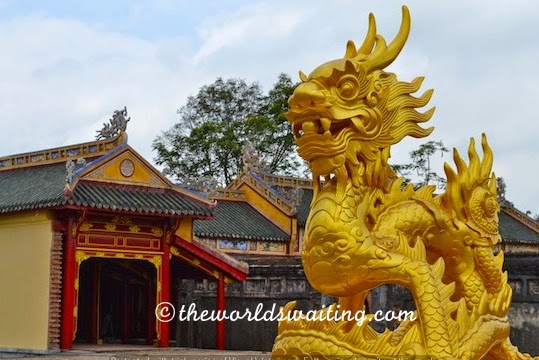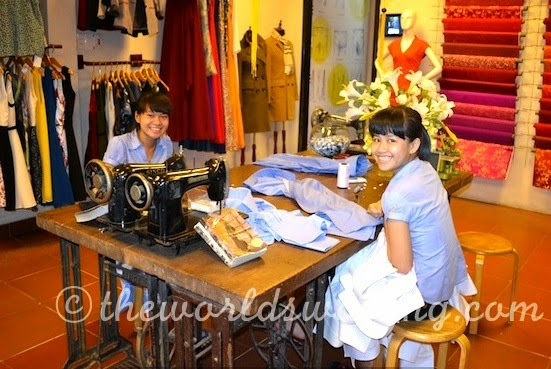
Hue’s Impressive Imperial Citadel
Little did we know that visiting Hue’s old fortified city, known as the citadel, was going to involve so much guesswork. Tragically, not much of Vietnam’s one-time royal domain and capital city remains in tact today, but that makes it all the more interesting to explore. Home to the Nguyen dynasty, at the time of construction, Hue’s citadel would have been a city fit for a king. It covered about five square kilometers on the north bank of the Perfume River and featured an imperial enclosure and the Forbidden Purple City where only emperors, concubines and invited guests were permitted. There were also temple compounds and residences. However, what visitors find these days provides a rather sad reflection of the past.

Hue’s history
Hue’s location, about halfway down the coast of Vietnam put it very close to the demilitarized zone. As a result of this proximity, Hue has seen much conflict over the years. Hue suffered significant damage when the Vietnamese took on the French in 1947, and then again during the Tet Offensive in 1968 when the north Vietnamese bombed it before they took the city, and then the Americans bombed it to take it back. Interestingly, following these conflicts, many of the historic relics in Hue were neglected because the victorious communists saw them as an embarrassing reminder of imperial rule and they now lie in a very poor state of repair. However, with increasing interest from tourists, many historical areas are now being restored.
Exploring the Citadel
The Citadel was built in three concentric enclosures. The civic area surrounds the imperial, which surrounds the central Forbidden Purple City. Don’t expect to be spoon-fed the history though as very limited information is available. There is very little signage and it can be hard to decide where you are, making the Hue Citadel a location where a local guide can be invaluable.
Cot Co Flag Tower
Apparently the tallest flag tower in Vietnam, the 37metre Cot Co Flag Tower has dominated Hue’s skyline since 1809. During the Tet Offensive in 1968 the flag tower attracted the world’s attention when it flew the National Liberation Front’s yellow-starred banner.

Nine deities cannons
No ancient city would be complete without cannons! Nine impressive bronze cannons surround the main entrance to the Citadel. Four represent the seasons and five the elements, earth, fire, water, metal and wood. They are a symbol of the power and protection afforded to the capital city.
Ngo Mon Gate
The main entrance to the Citadel, Ngo Mon Gate, is right next to the flag tower. The gate features five doors, the central door was for the king, the two middle doors (either side of the central one) were for mandarins, and the outer two doors were for soldiers. As you enter the citadel you pass two large ponds full of big fish that follow you, hoping for a feed, as you walk along the edge.
Halls of the Mandarins
There are two halls, one for military mandarins and one for civic mandarins that used the halls as dressing areas when preparing for functions. They wore ceremonial robes, some of which are on display.
Forbidden Purple City
The 25 acre Forbidden Purple City was home to the queen, concubines, female servants and court eunuchs, and the only man allowed inside was the Emperor. Trespassing by any other male was a bad idea as it was punishable by death. There was once 60 buildings in the area but very little of them remains today because the area was badly damaged during the Tet Offensive.
Thai Hoa Palace
The grand throne palace of the emperors contains a grand throne (of course!) in a large room featuring 80 red lacquered wooden columns and golden dragons symbolising the Nguyen Dynasty.

Nine Dynastic Urns
Nine of the largest urns I have ever seen stand outside the Hien Lam Pavillion. Each of these enormous, dark-coloured urns has tremendous presence and is for one of the Nguyen emperors. Their power is represented in the ornate bas-relief carvings of powerful symbols.
The Mieu
Ten Nguyen emperors are honoured in The Mieu, which is a sort of memorial to them. Richly decorated tall chests line a long room, displaying a photo of each emperor. According to our guide, one emperor had over 140 children and another had none, despite having 131 wives, due to him having contracted mumps during childhood.

Hung Mieu
As any sensible chap knows, it is important to take good care of your mother. The Hung Mieu complex was dedicated to Emeror Gia Long’s mother and father in the 19th century and is traditionally where the Kings’ mothers lived. Ornately decorated, the buildings feature glazed carvings on the tiled roofs and dragons peer down from rooftops. The peaceful paved courtyard features small trees and flowers. Between here and the Royal Palace there is a very interesting display of historic photographs showing the Citadel and its inhabitants in their prime.

Hue Royal Theatre
The extravagantly decorated Royal Theatre would, in its heyday, have been an incredible venue for entertainment. Beneath the pagoda-style roof, the building has a colourful interior and is peppered with golden dragons.

Managing expectations
The key to enjoying a visit to Hue’s Citadel is to go expecting ruins. While some buildings are still in tact, they are very few and a lot of the Citadel has been reduced to rubble and weeds. The Citadel’s lure for tourists has been noticed however and reconstruction efforts are ongoing but they are far from complete. To avoid disappointment, due to the lack of information and signage available on site, I recommend hiring a local guide to show you around the Imperial Citadel or taking a detailed guidebook with you.




